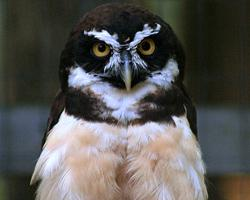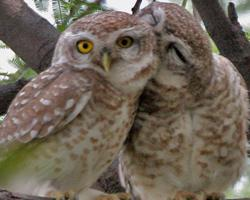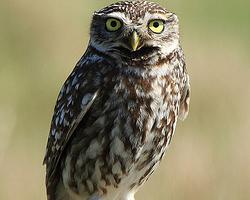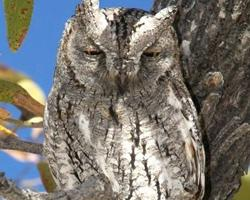
Poids et mesures
| Longueur | 46 cm |
|---|---|
| Longueur de la queue | 850 g |
Statut de conservation
| Menacé |
Description de l'animal
The Spectacled Owl (Pulsatrix perspicillata) is a captivating species of owl known for its distinctive appearance and intriguing behaviors. Native to the tropical forests of Central and South America, this owl has carved out a niche in a range of habitats, from dense rainforests to more open woodlands and even plantations. Its presence spans from southern Mexico, through Central America, to as far south as Argentina, making it a common sight in much of its range, although it remains elusive and a treat to behold for birdwatchers and nature enthusiasts.Characterized by its striking facial features, the Spectacled Owl gets its common name from the white feather markings around its eyes, which resemble a pair of spectacles. These white markings stand out against the dark plumage of its face, creating a stark contrast that is both beautiful and dramatic. The owl's overall plumage is predominantly dark brown, with a lighter, barred chest and belly. Juveniles display a markedly different appearance, being almost entirely white with a few dark spots, and gradually acquire their adult plumage as they mature.
The Spectacled Owl is a medium to large owl, with females typically larger than males, a common trait among owls. They can reach lengths of 43 to 52 centimeters (17 to 20 inches) and have a wingspan that can extend up to 33 inches. Their large, powerful talons and sharp beak make them formidable hunters, capable of taking down a variety of prey.
Diet-wise, the Spectacled Owl is a carnivore with a preference for small mammals such as rodents, but it also hunts birds, insects, and occasionally reptiles and amphibians. Its hunting strategy involves perching silently in the canopy or on a high branch, waiting patiently before swooping down on its prey with precision and agility.
The call of the Spectacled Owl is a deep, baritone hooting that can be heard echoing through the forest at night. These vocalizations play a crucial role in communication between owls, especially during the breeding season. Spectacled Owls are monogamous and typically form long-lasting pair bonds. They nest in tree cavities or abandoned nests of other large birds, where they lay and incubate a clutch of one to two eggs.
Spectacled Owls do not migrate and are known to occupy and defend territories year-round. They are nocturnal and elusive, making them difficult to spot in their natural habitat. However, their distinctive calls often betray their presence, providing clues to their whereabouts even if they remain hidden from view.
Conservation-wise, the Spectacled Owl is currently classified as Least Concern by the International Union for Conservation of Nature (IUCN), indicating that it is not currently at significant risk of extinction. However, like many forest-dwelling species, it faces threats from habitat destruction and fragmentation due to deforestation and agricultural expansion. Conservation efforts aimed at preserving tropical forests are crucial to ensuring the long-term survival of the Spectacled Owl and countless other species that depend on these ecosystems.
In summary, the Spectacled Owl is a remarkable bird, both in appearance and behavior. Its adaptation to a variety of tropical habitats, combined with its striking looks and intriguing life history, make it a fascinating subject for study and a cherished species for bird enthusiasts and conservationists alike.
Animaux similaires
Nouvelles photos d'animaux
Top 10 des animaux
- Dolphin gull (Leucophaeus scoresbii)
- Diana monkey (Cercopithecus diana)
- Moustached guenon (Cercopithecus cephus)
- Galápagos tortoise (Geochelone nigra complex)
- Japanese macaque (Macaca fuscata)
- Stone loach (Barbatula barbatula)
- Russian tortoise (Testudo horsfieldii)
- Greek tortoise (Testudo graeca)
- Common flying dragon (Draco volans)
- Vendace (Coregonus albula)


